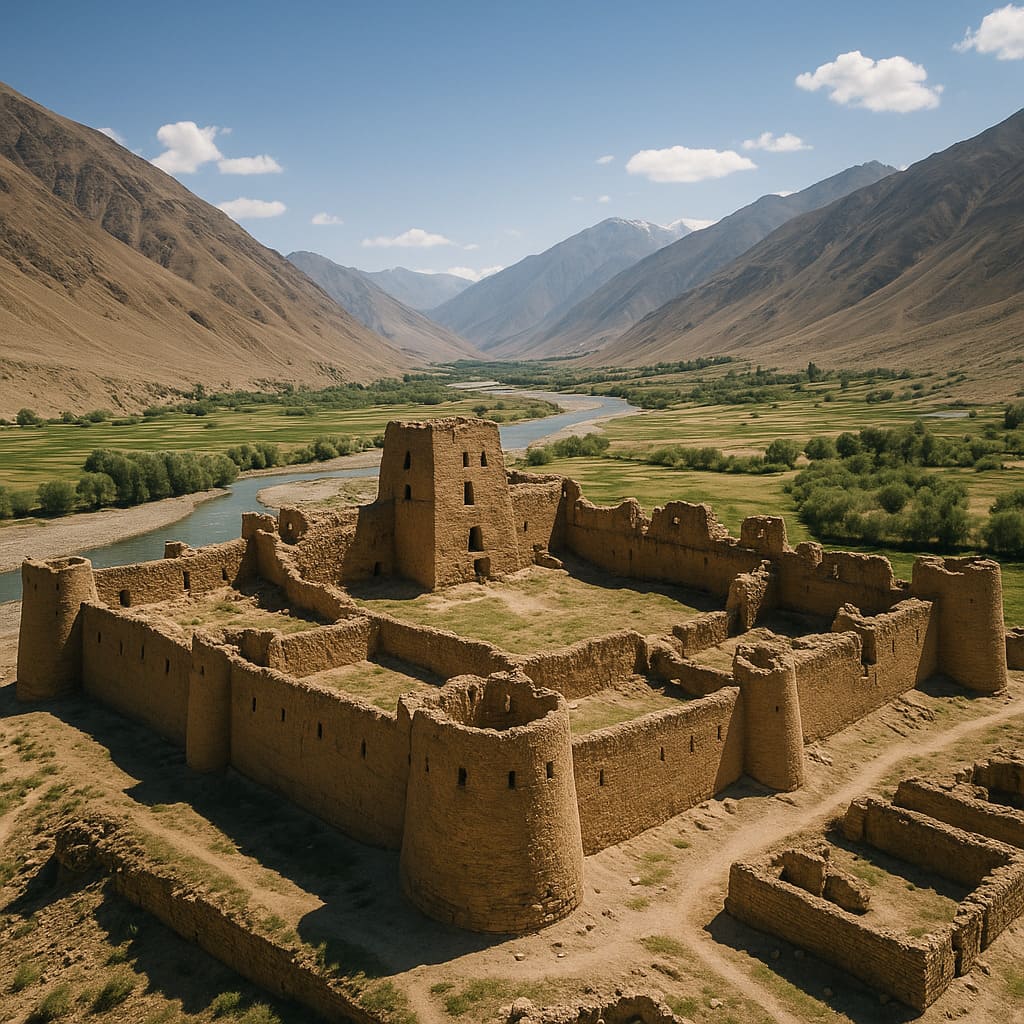Qala-e Panja in Wakhan, is one of many fascinating sites that both foreign visitors and local tourists can explore while they visit Afghanistan and exploring Badakhshan Province. Nestled amid the scenic expanse of Wakhan, Qala-e Panja serves as a vibrant testament to Afghanistan’s rich historical and cultural heritage. Its distinctive architecture, tangible vestiges of bygone era, and intriguing historical undercurrents make it a compelling destination that transcends the confines of time, offering a distinct immersive experience.
Qala-e Panja Most Important Events
- Qala-e Panja Fortress Construction: One of the most impactful historical moments was undoubtedly the construction of the Qala-e Panja fortress. Built centuries ago, this architectural marvel has withstood the wrath of time and played a significant role in the region’s defense.
- Silk Road Era: Qala-e Panja’s prime location along the Silk Road brought it into prominence as a vital trading hub. This era defined its economic growth and fueled cultural and historical developments.
- Wakhan Corridor Development: The recognition of the region as the Wakhan Corridor was a crucial development that cast a global spotlight on Qala-e Panja. This significantly boosted its prominence and tourism appeal.
History of Qala-e Panja in Wakhan
The history of Qala-e Panja strains to the early centuries. Its early mention, encoded in dusty parchments and travelogues of the Silk Route era, bespeak its lofty historical credentials. The emblematic Qala-e Panja fortress dates back to this time. It was seen as the protective barricade for the region, sheltering people from invasions and conflicts.
The reason why Qala-e Panja gained increased significance was its strategic location along the ancient Silk Road. This historical trade route connected the East and the West, becoming a flux point for cultural, economic, and intellectual interchanges. Qala-e Panja basked in this confluence, absorbing influences and creating a rich eclectic culture that it holds onto till today.
Fast-forward to the 19th century, the region turned a decisive corner in history when it was identified as the Wakhan Corridor—a geopolitical creation that shaped the region’s future. Qala-e Panja’s prominence grew, its historical and cultural landscape drew attention beyond its geographical boundaries.
Why It’s Important to Afghan History
Qala-e Panja occupies a unique place in Afghan history. It’s almost like a living chronicle that provides insights into Afghanistan’s rich past. Its glorious fortress, for instance, reveals the architectural mastery of ancient Afghan civilizations and their prowess in engineering artistry.
Moreover, its history as a Silk Road hub throws light on Afghanistan’s economic and cultural interactions with the global world during ancient times. It symbolizes a time when Afghanistan stood at the crossroads of cultural exchange, adding depth and diversity to the country’s historical narrative.
Why to Visit Qala-e Panja
Qala-e Panja holds a special place on Afghanistan’s cultural tourism map for several reasons. The architectural spectacle of Qala-e Panja fortress is certainly a major drawing card. Its high walls, visible signs of aged bricks, and aura create a renewing connection with the past.
Not to forget the scenic surroundings. Nestled in Wakhan, Qala-e Panja is swathed in a rich tapestry of natural beauty. The panoramic views, heartwarming sunsets, and the serene vibe give a wonderful opportunity to soak in nature’s charm and the region’s arresting beauty.
Top highlights of Qala-e Panja include:
- The ancient fortress.
- The beautiful Wakhan landscapes.
- Traces of Silk Road history.
- Wakhan’s traditional local culture.
- Experiencing local food and hospitality.
Located in the northeastern corner of Afghanistan, Qala-e Panja can be best accessed by taking a road trip from nearby cities like Ishkashim. The best time to visit is during the summer months when the weather is favorable for exploration.
Cultural & Tourist Significance
Qala-e Panja holds immense cultural significance owing to its unique location. It essentially served as a melting pot for diverse cultures, thanks to its position on the Silk Road. This intermingling of cultures reflects in its local customs, traditions, and even in the local dialects spoken by communities.
Touristically, Qala-e Panja is a treasure trove. Its cultural richness, history, and scenic beauty hold an enduring appeal that extends beyond borders. This charm is enhanced manifold by the warmth and distinctive traditions of local Wakhi and Kyrgyz communities residing in the area.
Moreover, Qala-e Panja’s significance as a part of the Wakhan Corridor amplifies its tourist appeal. The historical corridor’s distinct geography and charm weave a unique travel narrative that is both intriguing and exotic, offering a refreshing detour from typical tourist trails.
Interesting Facts
There’s much more to Qala-e Panja than meets the eye. An interesting facet is the network of ancient trails leading from Qala-e Panja to other parts of the Silk Road. These paths resound with the echoes of ancient travelers, adding a unique allure to the landscape.
Another lesser-known fact is the distinct dialect spoken by locals. Known as Wakhi, it’s an Indo-European language brimming with phonetic richness. It reflects the centuries of cultural and linguistic exchanges along the Silk Route.
Finally, legends too have a place in Qala-e Panja. Folklore spin tales of mythical creatures and caravans that once traversed the ancient trading route. Digging deeper into these tales, one might realize that they form an inseparable part of Qala-e Panja;s charm enhancing its enigmatic allure.


